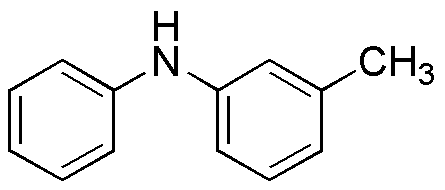N-Phenyl-m-toluidine is widely utilized in research focused on:
- Dyes and Pigments: This compound serves as an intermediate in the synthesis of various dyes, particularly in the textile industry, enhancing color fastness and vibrancy.
- Rubber Industry: It is used as an antioxidant and curing agent in rubber formulations, improving durability and resistance to aging, which is crucial for tire and sealant production.
- Pharmaceuticals: N-Phenyl-m-toluidine plays a role in the development of certain pharmaceutical compounds, contributing to the creation of effective medications with specific therapeutic effects.
- Polymer Production: This chemical is involved in the manufacturing of polymers, providing properties such as increased strength and thermal stability, which are essential for various applications in packaging and construction.
- Research and Development: It is frequently used in laboratories for synthesizing new compounds, allowing researchers to explore innovative materials and chemical reactions.
General Information
Properties
Safety and Regulations
Applications
N-Phenyl-m-toluidine is widely utilized in research focused on:
- Dyes and Pigments: This compound serves as an intermediate in the synthesis of various dyes, particularly in the textile industry, enhancing color fastness and vibrancy.
- Rubber Industry: It is used as an antioxidant and curing agent in rubber formulations, improving durability and resistance to aging, which is crucial for tire and sealant production.
- Pharmaceuticals: N-Phenyl-m-toluidine plays a role in the development of certain pharmaceutical compounds, contributing to the creation of effective medications with specific therapeutic effects.
- Polymer Production: This chemical is involved in the manufacturing of polymers, providing properties such as increased strength and thermal stability, which are essential for various applications in packaging and construction.
- Research and Development: It is frequently used in laboratories for synthesizing new compounds, allowing researchers to explore innovative materials and chemical reactions.
Documents
Safety Data Sheets (SDS)
The SDS provides comprehensive safety information on handling, storage, and disposal of the product.
Product Specification (PS)
The PS provides a comprehensive breakdown of the product’s properties, including chemical composition, physical state, purity, and storage requirements. It also details acceptable quality ranges and the product's intended applications.
Certificates of Analysis (COA)
Search for Certificates of Analysis (COA) by entering the products Lot Number. Lot and Batch Numbers can be found on a product’s label following the words ‘Lot’ or ‘Batch’.
Numéro de catalogue
Numéro de lot/série
Certificates Of Origin (COO)
This COO confirms the country where the product was manufactured, and also details the materials and components used in it and whether it is derived from natural, synthetic, or other specific sources. This certificate may be required for customs, trade, and regulatory compliance.
Numéro de catalogue
Numéro de lot/série
Safety Data Sheets (SDS)
The SDS provides comprehensive safety information on handling, storage, and disposal of the product.
DownloadProduct Specification (PS)
The PS provides a comprehensive breakdown of the product’s properties, including chemical composition, physical state, purity, and storage requirements. It also details acceptable quality ranges and the product's intended applications.
DownloadCertificates of Analysis (COA)
Search for Certificates of Analysis (COA) by entering the products Lot Number. Lot and Batch Numbers can be found on a product’s label following the words ‘Lot’ or ‘Batch’.
Numéro de catalogue
Numéro de lot/série
Certificates Of Origin (COO)
This COO confirms the country where the product was manufactured, and also details the materials and components used in it and whether it is derived from natural, synthetic, or other specific sources. This certificate may be required for customs, trade, and regulatory compliance.

